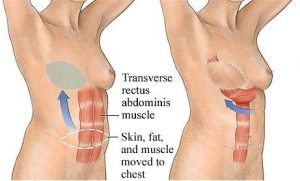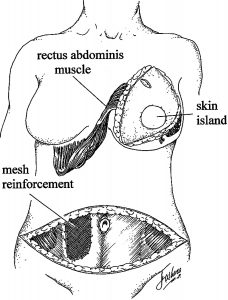The Pedicled Transverse Rectus Abdominis Flap
 The pedicled Tram Flap reconstruction, is a procedure that uses the muscle, fat and skin from your tummy to create a new breast.
The pedicled Tram Flap reconstruction, is a procedure that uses the muscle, fat and skin from your tummy to create a new breast.
TRAM flap – full name , Transverse Rectus Abdominal Myocutaneous flap is termed pedicled as the flap is still attached to the body versus a free flap, where it is disconnected from the body.
Most women have enough tissue in their tummy to create a breast and would require a second smaller procedure to create a nipple and areola. There are various ways of doing a TRAM flap. Here we describe the pedicled or attached Tram flap. This method transposes the pedicled or attached flap through a tunnel under your skin up to your chest area to recreate a new breast mound.
What to expect during the pedicled Tram Flap Procedure
The reconstructive team will evaluate your suitability for TRAM flap reconstruction.
Two weeks prior to the definitive procure you would have a delay procedure. The delay procedure is scheduled so as to improve the reliability of the flap and decrease the possibility of developing complications.
The delay procedure will take place under general anaesthesia. It involves cutting the lower border of the flap/area to be used to reconstruct your breast. You will be discharged the following day in most cases.
During the definitive procedure 2 weeks later. The plastic surgeon will use a skin marker to design the area on your lower abdomen that will be used to reconstruct your future breast. When the incision of the flap is closed it will become a line that crosses your tummy from hip to hip. You will receive a general anaesthetic thus you will be asleep and pain free during the procedure. On the skin markings an incisions will be made by the surgeon to raise the skin and muscle flap. A tunnel will be created under your skin so that the flap can be relocated.
 The abdominal skin flap will be positioned to fill in the skin that was lost during the mastectomy procedure and the surgeon will arrange the tissue so at to form a new breast mound. Drains will be placed in the new breast as well as in the abdomen so as to prevent the build-up of fluid and blood from the operative procedure.
The abdominal skin flap will be positioned to fill in the skin that was lost during the mastectomy procedure and the surgeon will arrange the tissue so at to form a new breast mound. Drains will be placed in the new breast as well as in the abdomen so as to prevent the build-up of fluid and blood from the operative procedure.

